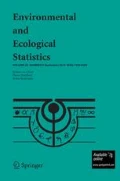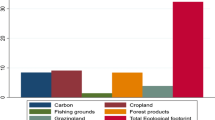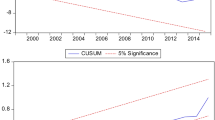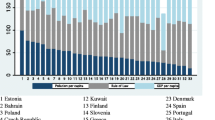Abstract
The prolonged issue of environmental degradation, especially in developing countries, has urgently called for a solution by first identifying the source of the problem. Poverty has been identified as among the core cause of environmental degradation. But we also foresee the prospect of migrations from poor countries as an additional force that leads to the worsening of environmental deterioration. Empirically, this paper investigates the effect of migration on the environmental deterioration of 29 developing countries for the period between 1980 and 2019. Adopting the panel cointegration approach, the paper finds evidence that deterioration seems to be higher in countries with a higher level of migration. Although the results could be undesirable to the host countries, the best and win–win solution could be achieved by the government of the host countries, either with or without the assistance of the United Nations, to introduce more assistance to support their life and educate their citizens to be more environmentally savvy.


Similar content being viewed by others
Data availability
The datasets used and/or analyzed during the current study are available from the corresponding author on reasonable request.
Notes
When high income is highlighted, in this study, we also stress that all factors that have a connection with income (or GDP in macro study) such as industrialization, urbanization, and deforestation are all embedded or factorized in the income itself. Hence, to conserve space, these three factors will not be discussed in this study.
Issue could refer to either on ‘how to assist them’ or ‘what would be their implication on host country’.
We plan to apply any hypothesis or theory which supports the linkage between migration and environmental degradation. Unfortunately, we could not find any single hypothesis to refer to. At best, as reflected in limited literature available about the topic, some past studies argue on the types of activities that might be done by the migrated people who may be harmful to the environment in order to justify the link between the two. The detail is available in the literature section but hardly we can term it as the theory for the time being. Although the model does not start with migration-environment theory, this approach is still acceptable and common in modelling.
We plan to apply any hypothesis or theory which supports the linkage between migration and environmental degradation. Unfortunately, we could not find any single hypothesis to refer to. At best, as reflected in limited literature available about the topic, some past studies argue on the types of activities that might be done by the migrated people who may be harmful to the environment in order to justify the link between the two. The detail is available in the literature section but hardly we can term it as a theory for the time being. Although the model does not start with migration-environment theory, this approach is still acceptable and common in modelling.
The null hypothesis for IPS also implies auxiliary assumptions regarding the individual effects, especially, αi = 0 for all i = 1, …, N.
Ignorance and illiteracy about environment could also be the explanations.
References
Acaravci A, Ozturk I (2010) On the relationship between energy consumption, CO2 emissions and economic growth in Europe. Energy 35(12):5412–5420
Acharyya J (2009) FDI, growth and the environment: evidence from India on CO2 emission during the last two decades. J Econ Dev 34(1):43
Addai K, Serener B, Kirikkaleli D (2022) Empirical analysis of the relationship among urbanization, economic growth and ecological footprint: evidence from Eastern Europe. Environ Sci Pollut Res. https://doi.org/10.1007/s11356-021-17311-x
Al-Mulali U, Saboori B, Ozturk I (2015) Investigating the environmental Kuznets curve hypothesis in Vietnam. Energy Policy 76(January):123–131
Ang JB (2007) CO2 emissions, energy consumption, and output in France. Energy Policy 35(10):4772–4778
Apergis N, Payne JE (2009) CO2 emissions, energy usage, and output in Central America. Energy Policy 37(8):3282–3286
Apergis N, Payne JE, Menyah K, Wolde-Rufael Y (2010) On the causal dynamics between emissions, nuclear energy, renewable energy, and economic growth. Ecol Econ 69(11):2255–2260
Atici C (2009) Carbon emissions in Central and Eastern Europe: environmental Kuznets curve and implications for sustainable development. Sustain Dev 17(3):155–160
Babu SC, Hassan R (1995) International migration and environmental degradation—the case of Mozambican refugees and forest resources in Malawi. J Environ Manag 43(3):233–247
Banerjee, A., & Carrion-i-Silvestre, J. L. (2011). Testing for panel cointegration using common correlated effects (No. 11–16).
Begum RA, Sohag K, Abdullah SMS, Jaafar M (2015) CO2 emissions, energy consumption, economic and population growth in Malaysia. Renew Sustain Energy Rev 41:594–601
Bilsborrow, R.E. (1992). Rural poverty, migration, and the environment in developing countries: three case studies, policy research working paper, World Development Report, WPS 1017 (The World Bank, Washington, DC).
Black R, Bennett SR, Thomas SM, Beddington JR (2011) Climate change: migration as adaptation. Nature 478(7370):447–449
Bremner J, Hunter LM (2014) Migration and the environment. Popul Bull 69(1):1–12
Curran S (2002) Migration, social capital, and the environment: Considering migrant selectivity and networks in relation to coastal ecosystems. Popul Dev Rev 28(1):89–125
Deshingkar P (2006) Internal migration, poverty and development in Asia: including the excluded. IDS Bull 37(3):88–100
Gao C, Tao S, He Y, Su B, Sun M, Mensah IA (2021) Effect of population migration on spatial carbon emission transfers in China. Energy Policy 156:112450
Holtz-Eakin D, Selden TM (1995) Stoking the fires? CO2 emissions and economic growth. J Public Econ 57(1):85–101
Ibrahim MH, Law SH (2014) Social capital and CO2 emission—output relations: a panel analysis. Renew Sustain Energy Rev 29(January):528–534
Im KS, Pesaran MH, Shin Y (2003) Testing for unit roots in heterogeneous panels. J Econom 115(1):53–74
Intergovernmental Panel on Climate Change (IPCC, 2006). 2006 IPCC guidelines for national greenhouse gas inventories: agriculture, forestry and other land use (AFOLU), Vol. 4. Prepared by the National Greenhouse Gas Inventories Programme, Institute for Global Environmental Strategies (IGES): Hayama, Japan. Accessed January 2019 from https://www.ipccnggip.iges.or.jp/public/2006gl/pdf/4_Volume4.
Jebli MB, Youssef SB, Ozturk I (2016) Testing environmental Kuznets curve hypothesis: the role of renewable and non-renewable energy consumption and trade in OECD countries. Ecol Ind 60(January):824–831
Lau LS, Choong CK, Eng YK (2014) Investigation of the environmental Kuznets curve for carbon emissions in Malaysia: do foreign direct investment and trade matter? Energy Policy 68(May):490–497
Maddala GS, Wu S (1999) A Comparative study of unit root tests with panel data and a new simple test. Oxf Bull Econ Stat 61(S1):631–652
Marchal P, Madre JL, Yuan S (2011) Postprocessing procedures for person-based global positioning system data collected in the French National Travel Survey 2007–2008. Transp Res Rec 2246(1):47–54
Masron TA, Subramaniam Y (2018) The environmental Kuznets curve in the presence of corruption in developing countries. Environ Sci Pollut Res 25(13):12491–12506
McAuliffe M, Ruhs M (2017) World migration report 2018. International Organization for Migration, Geneva
McLeman R, Smit B (2006) Migration as an adaptation to climate change. Clim Change 76(1–2):31–53
Mukhopadhyay K (2006) Impact on the environment of Thailand’s trade with OECD countries. Asia-Pac Trade Invest Rev 2(1):25–46
OECD (Organisation for Economic Co-operation and Development) (2008) OECD factbook 2008: economic, environmental and social statistics. OECD, Paris
Oliver‐Smith A (2012) Debating environmental migration: society, nature and population displacement in climate change. J Int Dev 24(8):1058–1070
Ozcan B (2013) The nexus between carbon emissions, energy consumption and economic growth in Middle East countries: a panel data analysis. Energy Policy 62(November):1138–1147
Ozturk I, Acaravci A (2010) CO2 emissions, energy consumption and economic growth in Turkey. Renew Sustain Energy Rev 14(9):3220–3225
Pao HT, Tsai CM (2011) Modeling and forecasting the CO2 emissions, energy consumption, and economic growth in Brazil. Energy 36(5):2450–2458
Pedroni P (1999) Critical values for cointegration tests in heterogeneous panels with multiple regressors. Oxf Bull Econ Stat 61(S1):653–670
Pedroni P (2004) Panel cointegration: asymptotic and finite sample properties of pooled time series tests with an application to the PPP hypothesis. Econom Theor 20(3):597–625
Pesaran MH (2007) A simple panel unit root test in the presence of cross-section dependence. J Appl Econom 22(2):265–312
Ren S, Yuan B, Ma X, Chen X (2014) International trade, FDI (Foreign Direct Investment) and embodied CO2 emissions: a case study of Chinas industrial sectors. China Econ Rev 28(March):123–134
Shafiei S, Salim RA (2014) Non-renewable and renewable energy consumption and CO2 emissions in OECD countries: a comparative analysis. Energy Policy 66(March):547–556
Shahbaz M, Nasreen S, Abbas F, Anis O (2015) Does foreign direct investment impede environmental quality in high-, middle-, and low-income countries? Energy Econ 51(July):275–287
Smarzynska, B. K., & Wei, S.J. (2001). Pollution haven and foreign direct investment: dirty secret or popular myth? Working paper series, 1–31, World Bank: Washington, DC.
Tamazian A, Rao BB (2010) Do economic, financial and institutional developments matter for environmental degradation? Evid Transitional Econ Energy Econ 32(1):137–145
UNHCR (2016) Global trends: forced displacement in 2015. UNCHR, Geneva, Switzerland
United Nations (2018) International migration report 2017-highlights. United Nations, New York
Warner K, Hamza M, Oliver-Smith A, Renaud F, Julca A (2010) Climate change, environmental degradation and migration. Nat Hazards 55(3):689–715
Westerlund J (2005) New simple tests for panel cointegration. Economet Rev 24(3):297–316
Wilkie ML, Cumani R, Martucci A, Latham J (2008) The Global forest resources assessment 2010. In: Seussa R (ed) Terrestrial observation of our planet. FAO, Rome, pp 32–33
World Bank (2018). World Development Indicators. Accessed from October 2018 http://data.worldbank.org/indicator.
Acknowledgements
Not applicable.
Funding
Universiti Teknologi Malaysia, UTM Fundamental Research (UTMFR) (Grant No: Q.J130000.3855.21H98).
Author information
Authors and Affiliations
Corresponding author
Ethics declarations
Conflicts of interest
The authors have no conflicts of interest to declare.
Additional information
Handling Editor: Luiz Duczmal.
Appendix
Rights and permissions
Springer Nature or its licensor (e.g. a society or other partner) holds exclusive rights to this article under a publishing agreement with the author(s) or other rightsholder(s); author self-archiving of the accepted manuscript version of this article is solely governed by the terms of such publishing agreement and applicable law.
About this article
Cite this article
Subramaniam, Y., Masron, T.A. & Loganathan, N. The impacts of migrants on environmental degradation in developing countries. Environ Ecol Stat 30, 17–40 (2023). https://doi.org/10.1007/s10651-022-00552-5
Received:
Accepted:
Published:
Issue Date:
DOI: https://doi.org/10.1007/s10651-022-00552-5




